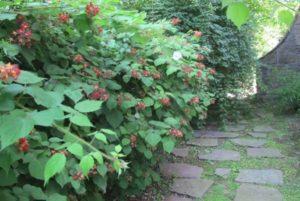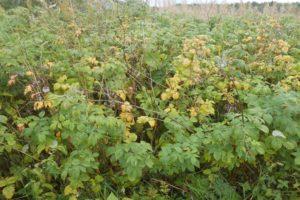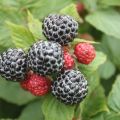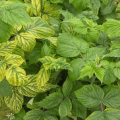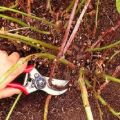How to properly care for remontant raspberries for a good harvest
Raspberries are a delicious, healthy berry, thanks to selection work, they can be present on tables all summer and autumn. Repaired varieties are distinguished by abundant and long, almost continuous fruiting. How to properly care for remontant raspberries in order to get a good harvest and extend the life of the bushes, you should find out in advance.
Content
- 1 What is the difference between remontant raspberries?
- 2 The advantages and disadvantages of culture
- 3 How many remontant raspberries grow
- 4 We plant raspberries on the site
- 5 How to properly care for remontant raspberries
- 6 How to properly handle diseases and pests
- 7 The main mistakes of novice gardeners
- 8 Tips from seasoned gardeners: how to speed up the ripening of remontant raspberries
What is the difference between remontant raspberries?
Repaired raspberry varieties differ from others in their ability to form berries on annual and biennial shoots, bloom repeatedly and bear fruit abundantly during the summer-autumn period, some before the first frost. In varieties of remontant selection, young shoots from the underground part of the bush grow annually, in which, along with an adult bush, a crop of raspberries is formed at the top.
By winter, on a young shoot, the upper fruiting part dries up, the next year forming, like in ordinary varieties, additional branching shoots on which berries appear, but smaller in size than in the previous year. Therefore, the value of remontant raspberries is in the fruiting of large, tasty berries on young shoots.
The advantages and disadvantages of culture
Repaired raspberries are a very popular crop among farmers and private households due to their many advantages over conventional varieties.
Benefits of remontant varieties of raspberries:
- the size of the berries is larger than that of the usual;
- bountiful harvest with high quality, tasty berries;
- multiple fruiting, 2 times per season;
- resistance to diseases and pest attacks;
- high frost resistance, does not require shelter for the winter;
- the ability to grow as an annual crop;
- bears fruit the next year after planting;
- produces little root shoots, which allows not to thicken the planting of bushes.
Disadvantages of remontant raspberries:
- high cost of seedlings;
- it is necessary to monitor the level of acidity of the soil, properly cut and fertilize often;
- the landing site must be sunny;
- the taste of the berry is variable and depends on many factors, weather, care, planting site;
- difficult to propagate, some varieties give almost no new shoots.

How many remontant raspberries grow
After planting the bushes, the seedlings quickly adapt and the next year they give the first bountiful harvest. In one year, remontant varieties go through a full vegetation cycle. The first fruiting occurs on two-year shoots, the second on young ones. Raspberries of remontant varieties, with good care and a change of place, will bear fruit every 4-5 years for 10-12 years.
Under unfavorable conditions, improperly selected place, overfeeding with fertilizers or in their absence, the period of fruiting and life of raspberries will be 3-4 years.
We plant raspberries on the site
Repaired raspberries are a stronger, more unpretentious plant, but you should still observe agricultural techniques, planting dates, choice of place and soil, planting technique, caring for it.
In what time frame to plant a culture
Planting dates for remontant raspberry varieties may shift depending on weather conditions and the region. Gardeners are planted in spring and autumn, the main condition for such plantings is high-quality remontant raspberry material, suitable soil conditions and location. Planting in open ground or in a greenhouse has its own nuances in every season.
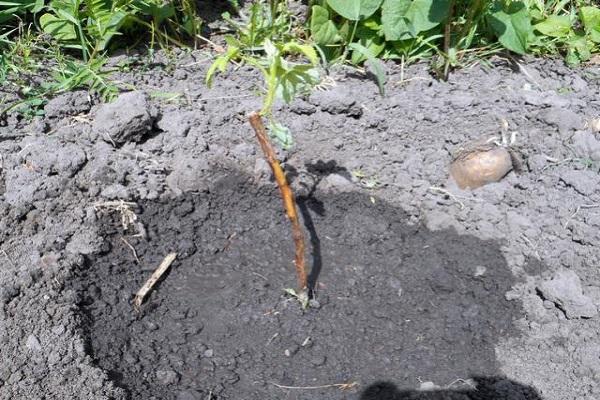
In the open field
Tips for choosing the time of planting remontant raspberry seedlings in the open field and caring for them.
Spring planting of raspberries is recommended for the Northern regions, the Urals, Siberia, the Far East, where severe frosts are possible in the fall, in September:
- Before the beginning of the growing season, before the appearance of buds, from mid-April to the first decade of May.
- After the weather stabilizes, the threat of frost will pass, the sunny day will extend to 12 hours a day, and the soil temperature will be 12-15 degrees.
- Planting is possible at the end of May - the first half of June, but only those seedlings of remontant raspberries that were stored in cold chambers and their growing season had not yet begun, that is, they were at a dormant stage.
After planting in the spring, in accordance with the agrotechnical manual, it will be easier to care for remontant raspberries in the summer, except for watering and inspecting for pests, nothing is required until autumn.

Autumn planting is suitable for regions located in the south, west, southeast, southwest. This is done 15-20 days before the first frost, the best time is the end of September - the first decade of October.
Since the climate in the southern regions is milder and warmer, it is possible to carry out not only autumn planting, but also spring planting, starting from mid-March. Caring for remontant raspberries in the fall after planting is reduced to the last nutritious watering and preparing a shelter for it.
In spring, it is better to plant medium-late and late varieties of remontant raspberries, which adapt until autumn, will go through the growing season and can even bring the first harvest on young shoots. In autumn, varieties with an early ripening period are planted, before the first frost, the bushes will adapt, go into a state of dormancy, and by the spring vegetative processes will begin, which will give an impetus to rapid growth and the first harvest of berries.

In the greenhouse
For cultivation in a greenhouse, early varieties are preferable, which can be planted in spring and autumn, but in the same way as in the open field, before the beginning of the growing season. Spring planting, from March to mid-May, autumn from late September to the third decade of October. Such cultivation of remontant raspberries is used to obtain a harvest from late spring to late autumn, but you can also use the method of continuous berry production. For this, planting is carried out from mid-January, then in March, at the end of May, by conveyor method.
Harvested shoots are cut off and left dormant until further growth and fruiting.
The advantages of growing in a greenhouse are many: early harvest and until late autumn, no influence of weather changes.The disadvantage of this method is that raspberries do not have a strong, bright aroma.
In the greenhouse, you can carry out both an autumn planting of remontant raspberries, starting from the first days of October, it does not require additional lighting, you only need to observe a temperature regime of 22-25 degrees, and spring.

Suitable soil for remontant raspberries
Repaired raspberries are whimsical in the choice of soil, since they bear fruit a lot and abundantly, they need more nutrients. The soil should be fertile, rich, moist, loose, light, preferably black soil with an acidity level of 5.5 and no more than 6.5. Also, the bushes will grow in loamy and sandy loam soils, but with a lower yield, although this can be corrected by applying organic fertilizers to the planting site and during the season.
Site selection and hole preparation
As for the site for remontant raspberry varieties, it should be sunny, but if the soil is dry, it is better to choose with partial shade or partial shade during the day. The side is south, southeast, southwest in the garden. The place is chosen near the fence or trellis are installed for tying bushes. It should be borne in mind that raspberries will begin to grow gradually, which means that it is not worth planting next to a place intended for growing garden crops, shrubs.

Landing scheme
The planting scheme of remontant raspberries depends on the number of seedlings and the goals pursued:
- single row;
- two-row;
- trench;
- dimple;
- nesting;
- curtain (in the form of natural thickets).
The single-row and double-row planting system of remontant bushes is more often used when growing raspberries in large volumes over a large area. A long ditch is dug 40-45 cm deep, for a single-row, the width is 40-50 cm, for a double-row - 80-100 cm. A mixture of peat, humus, ash and top soil is laid on the bottom of the ditch.
If the soil is too acidic, then slaked lime (fluff, dolomite flour, chalk) is added. In a single-row scheme, raspberry seedlings are planted in the center of the ridge at a distance of 35-50 cm, sprinkled with soil and watered abundantly. A two-row scheme involves planting raspberry seedlings in 2 rows of one ditch at a distance of 40-50 cm between each row.
The trench scheme is similar to a single-row, but differs in the depth of the ditch and the amount of applied organic fertilizers, which are laid out in layers for long-term feeding of the bushes.
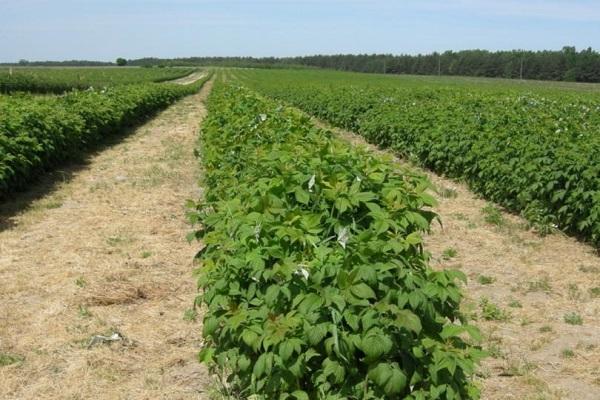
The pit pattern is used in private garden plots when the number of seedlings and space is limited. The site is dug up with the addition of organic or synthetic fertilizers, after which pits are dug up to 50 cm deep, 25-35 in diameter. The distance between the rows should be 0.5-1 m. A layer of fertilizers is laid on the bottom, which is sprinkled with soil and watered, bushes are planted on top, dripping with a mixture of the top layer of soil and compost.
The nesting scheme helps the gardener save on the number of supports for the raspberry bushes. A hole is dug up to 50 cm deep, up to 1 m in diameter, into which a mixture of fertilizers with fertile soil is also introduced, and 6-8 raspberry bushes are planted at an equal distance. A strong support is installed in the center of the circle, to which, as the raspberry grows, its shoots will be attached.

Dense plantings or in the form of a clump are most acceptable for regions with unfavorable weather conditions, with frequent and sudden frosts and severe frosts in winter. The bushes are planted at a close distance to each other, without any schemes, as new shoots grow, a small island with planted bushes overgrows, acquiring a natural look of thickets. This method allows the bushes to survive severe frosts favorably.
A thickened planting and nesting scheme are more often used in regions with dry soil and an unfavorable climate.In regions with wet soil, the best option is tape or dimple, which assumes a large distance between the bushes so that the bushes and berries do not rot inside the planting after rains.
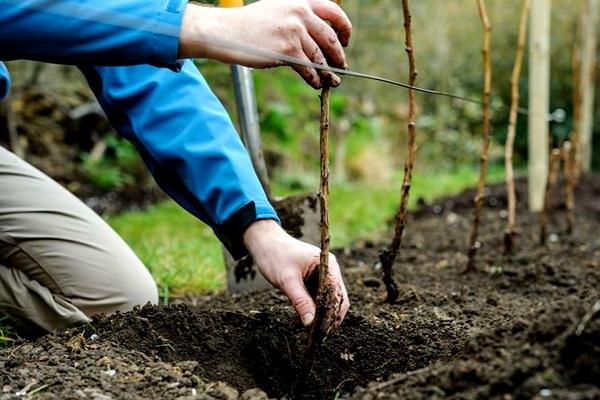
Technology of spring and autumn planting of remontant raspberries
Autumn and spring planting technology of remontant varieties does not differ significantly. For the spring planting of raspberry bushes, it is necessary to carry out preparatory work on the soil twice:
- in the fall, deeply, together with organic fertilizers, dig a site for planting;
- in spring, in 1-1.5 months, prepared trenches or holes are disinfected with special preparations and rotted fertilizers, ash, peat are added;
- 1 day or 3 hours before planting, the seedlings are rooted into the stimulants of root formation, the time depends on the purchased drug;
- seedlings of remontant raspberries are buried to the root collar, sprinkled with soil and mulch.
Watering can be carried out before planting the seedling, waiting for the water to be absorbed, or after planting, but be sure to put a layer of sawdust or dry grass on top so that the water does not evaporate quickly.
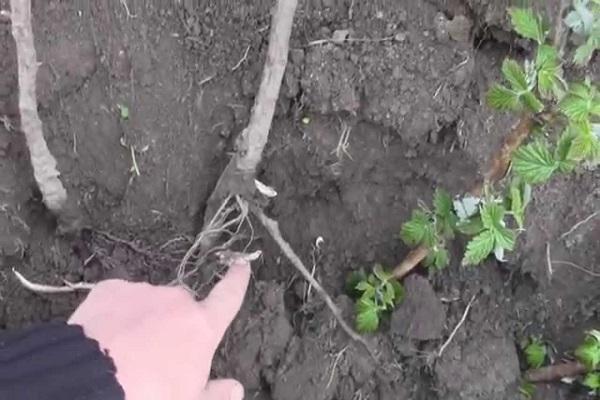
Autumn planting of remontant raspberries, as a rule, begins with soil preparation, which is better to start a year before planting bushes:
- in the fall, dig up a site for planting raspberries with manure;
- plant green manure plants in the spring;
- before flowering, green manures are mowed and dug up the site with them;
- in the fall, in September-October, holes or ditches are prepared in which young seedlings are planted.
If other garden plants grow on the site and the spread of raspberry bushes is undesirable, then around the site with seedlings at a distance of 50-70 cm from the bushes, slate, metal or plastic plates are dug in to a depth of 0.5 m, which will prevent the roots from growing beyond their limits.

Is it possible to plant remontant raspberries next to ordinary
Novice gardeners often wonder whether it is possible to plant a remontant raspberry variety with an ordinary one? Perhaps, cross-pollination will not occur, but gradually the offspring of the usual raspberry will clog the remontant variety with their shoots, which quickly germinate, unlike the second. There will also be problems with proper care, pruning, feeding.
The common variety bears fruit on the branches of the second year of life, which are then pruned. The remontant bears fruit twice, therefore, in the fall, the top is cut off on young, fruiting shoots. When the 2 varieties are planted together, after 2-3 years it will be impossible to distinguish between the bushes.
How to properly care for remontant raspberries
For raspberry varieties with remontant properties, proper spring, summer and autumn care is very important: pruning, mulching, timely watering and balanced feeding. The varieties are distinguished by strong immunity to diseases and pests, but preventive measures are needed to prevent diseases and attack by pests.
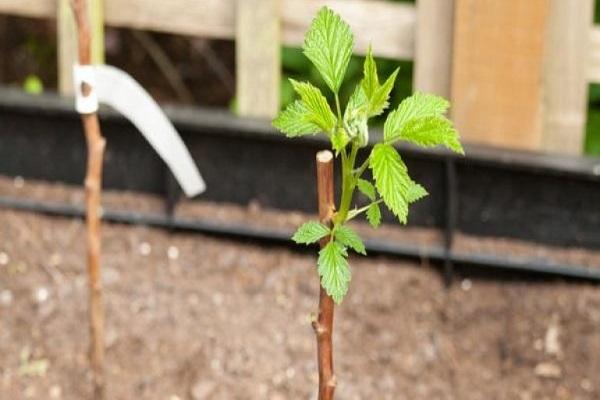
Spring care and pruning
Spring pruning of raspberry bushes is most favorable in the early stages, starting in March in the southern regions, from April - early May, the middle strip and northern regions. The pruning process is carried out during the beginning of shoot growth and bud swelling. The formation of bushes depends on the vigor of plant growth, variety, the optimal number of 6-12 healthy, strong shoots. Remove damaged, diseased, weak, frozen, dull, thickening shoots.
After 1-1.5 weeks, the top is cut off on the young, this is necessary so that the old shoots develop more actively and form fruitful brushes with raspberries. If healthy branches were accidentally cut off, then they can be divided into cuttings, soaked in a growth stimulator, and when the roots are released, planted with the rest of the raspberries.
It is better not to throw the cut tops away, but dry in the sun or in a dryer and use in winter to brew tea, which helps fight colds and stimulates the immune system.
One of the progressive methods is double cropping.This method forms shrubs for 2 spring seasons. In the first, annual shoots are cut at a level of 1 m, which stimulates the growth of lateral branches and the formation of more roots and root shoots. With it, actively growing young shoots are cut under the base, leaving 2-3 of the strongest ones.
In the second year, in spring, lateral branches are cut off by 10 cm on old shoots, which activates the formation of a larger number of ovaries. The method has a significant advantage, even if 1-2 shoots die after winter, this will have little effect on the loss of yield due to lateral shoots.

Soil loosening
In the spring, after removing the shelter around the raspberry bushes, they dug up the soil shallowly, while organic fertilizers can be added, this will increase the air permeability of the soil. The next loosening is carried out as the soil is compacted, in dry weather or after rains, as well as when removing weeds.
Shelter and mulching for the winter
In regions with a cold climate, where the soil freezes strongly in winter, all varieties are covered. To do this, use the method of autumn mulching around the bushes and in the aisles, laying a layer of straw, sawdust, cut grass. For remontant raspberry varieties that are grown at a biennial rate, it is best to use mulch or spunbond, densely covering the area around the bushes and aisles so that the root shoots do not freeze.
In autumn, the branches are bent to the soil, this should be done at the beginning of the season, when the branches are more elastic and green.
This method is used for remontant varieties in which raspberries are grown on annual shoots. They are tied into small bunches and incline to the soil by no more than 0.5 m. Between several such bunches, a peg is driven in, to which bunches of raspberry branches are tied alternately. Of course, there may be more berries on the branches, but here each gardener decides for himself what is more important to him: to get a harvest for the next year or to expect freezing.
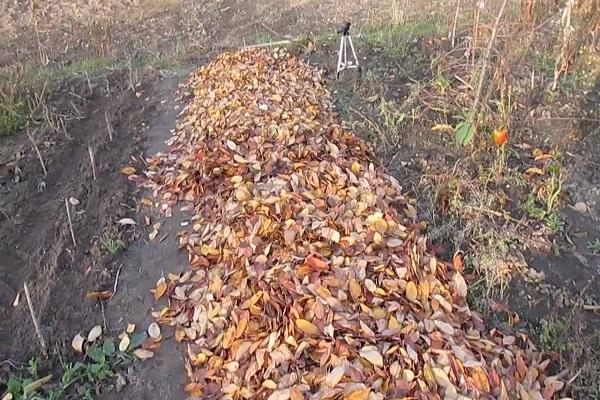
Standard varieties are covered with burlap or spunbond, creating a layer of straw or sawdust inside the shelter.
Rate and frequency of watering
During the spring-autumn period, remontant raspberries are irrigated 4-6 times. The first watering after the spring thaw is carried out if the winter was little snow and the soil is poorly moistened. If there was a lot of snow and the thaw passes with flooding of the site, then shallow (up to 10 cm) grooves need to be made in the row-spacing to drain excess melt water. The next watering is carried out:
- after 1-2 weeks in early May;
- during flowering;
- during the formation of fruits;
- with repeated flowering and the formation of polystyrene;
- autumn moisture in front of the shelter.
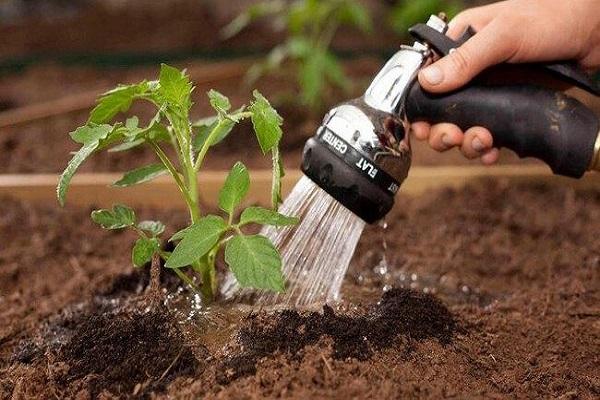
Watering methods for raspberries:
- drip is used for large areas of plantings;
- ditches (ditches), when water is allowed into the aisles of raspberry bushes, moistening the soil around;
- sprinkling is the most favorable way to irrigate not only the soil in the summer heat, but also to moisten the shoots and leaves.
Fertilizer
It is necessary to feed remontant raspberries 2-4 times per season, since its abundant fruiting draws out many useful substances from the soil. In the spring, rotted manure is brought in together with loosening the soil per 1 sq. m 10-liter bucket. During the beginning of the growing season, raspberries really need nitrogen, potassium, calcium, phosphorus, which can be purchased in retail chains and diluted according to the instructions.
For 1 bush use 50-60 g of superphosphate and 2-3 tbsp. l. potassium salt. Also, in early spring, you can bring peat and ash under the bush. Summer care for raspberry remontant varieties involves only watering with fertilizers under the bushes, usually it is carried out in June-July, when the shoots bloom.
In August and September, they are fed with phosphorus-potassium fertilizers or mulched with siderates.
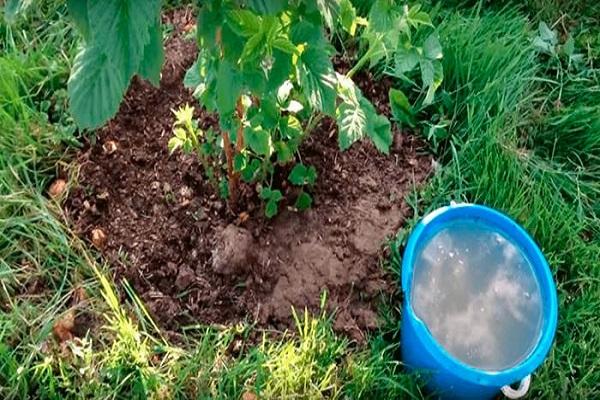
Mineral dressing
Urea, azofoska, ammonium nitrate, nitroammofoska are applied 1 time in the spring, but since these fertilizers contain a sufficient amount of phosphorus and potassium, then in subsequent feeding the volume of these elements should be less than the norm. For every 1 sq. m of planting area with raspberry bushes no more than 20 g of one of the fertilizers.
During all dressings, one should adhere to the rule: "less is better than more."
Folk remedies
Most gardeners use folk remedies for feeding:
- manure - cow, horse;
- bird droppings;
- siderates;
- infusions of weeds;
- rotted organic products.
Manure contains a lot of nitrogen, so it is best to apply it in the spring. Litter, weed infusion are bred in warm water and watered with raspberries in the middle of the season, during the formation of fruits. Siderata and rotted organic matter are best introduced in preparation for winter.
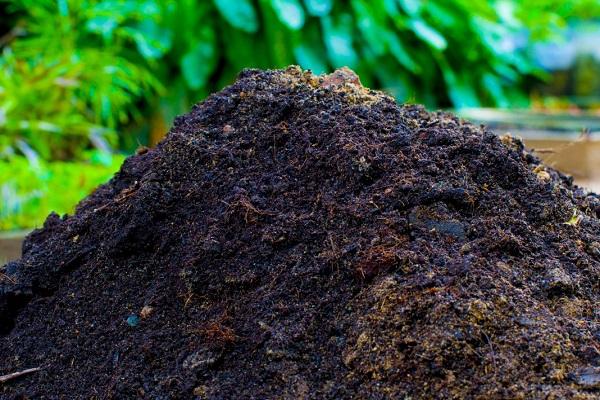
Tying and rationing raspberry branches
Raspberries need a garter and rationing of branches to ventilate the bushes so that berries do not rot or ripen for a long time, as well as to reduce the likelihood of infection with rot and viruses.
For the garter, different types of trellises are installed, several shoots are tied to them with an elastic rope every 2-3 m. Excess thickening branches are cut off, they will consume more nutrients and can provoke diseases.
How to properly handle diseases and pests
The most basic and effective preventive treatment for pests and diseases is carried out in the spring, in April - early May, before flowering. Also in autumn after picking berries. At other times, treatment with chemicals is dangerous to human life, since the forming fruits and ripe berries can absorb harmful substances.
In the spring, the drugs "Fitoverm", "Actellik", "Agravertin", "Nitrofen", copper sulfate, Bordeaux mixture, "Topaz" are used. They also plant calendula, marigolds, nasturtium, lavender, tansy, feverfew, pelargonium, chrysanthemums, as well as garlic, celery, onions, fennel from pests.

Overgrowth control
If the gardener does not need additional shoots to breed remontant raspberries, then they should be removed, since the plant spends a lot of energy and nutrients on their growth, which can reduce the yield. The shoots formed at a distance of more than 25 cm can be easily removed with a sharp shovel, which is buried 15-20 cm, since the raspberry root does not go deep, up to 40 cm.
The main mistakes of novice gardeners
It is worth familiarizing yourself with the main mistakes beginners make when growing remontant raspberries.
Raspberries do not grow
Poor growth or its complete stop on raspberry bushes often occurs due to non-observance of agricultural practices:
- a diseased seedling is selected;
- the plant is overfed with fertilizers;
- wrong landing site, depleted soil, little sunlight, drafts.

Does not bloom
One of the common reasons for the lack of flowering, ovary, is considered to be an incorrectly selected variety for the climatic zone. The soil on which the bushes are planted is too dense or with high acidity, alkalinity. Weather conditions, lack of long daylight hours, constant rains or drought also affect. Pests in the area that damage the root system: nematodes, ants.
Doesn't bear fruit: why
Lack of harvest on raspberry bushes can occur when overfeeding with organic fertilizers, diseases, pests or improper spring pruning.
Bushes often get sick
Repaired raspberries, just like ordinary ones, are often subject to diseases, especially gray rot and anthracnose, due to violation of the rules of agricultural technology, namely, too frequent watering, with thickened plantings and not carrying out sanitary pruning.

Tips from seasoned gardeners: how to speed up the ripening of remontant raspberries
For violent growth and the appearance of flowers at an earlier date, several methods of accelerating the process are carried out:
- In autumn, old shoots are cut off, leaving no stumps, the young are tied and bent to the ground. Cover with a thick layer of mulch on top.
- Arches are installed, on which the film is stretched in early spring to create a greenhouse effect and wake up the shoots ahead of time. With the arrival of constant heat, they gradually open, adapting to the temperature of the open ground.
- With the preparation "Baikal", observing the dosage, it is possible to warm up the soil ahead of time in spring, so that the root system wakes up faster.
Repaired raspberries do not differ in their useful properties from ordinary ones, but their yield is higher, although cultivation requires an investment of time and attention of the gardener.
